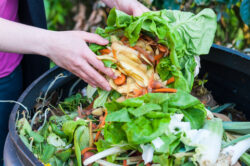Imagine a world where scraps and waste from food you are already eating can be turned into cost effective, chemical free and totally natural fertilizer for your garden! With composting, this imagined world is a completely attainable reality! Food scraps happen every day, all of the time.
From the banana peels to the potato rinds, the amount of scraps produced can be daunting if you were to gather it all up. That combined with the price of fertilizer means that composting can be your best friend when it comes to repurposing and reducing waste. After getting started here, be sure to further your research with Montana Grant’s composting piece by clicking here!
WHERE
The first step to composting is deciding where you’re going to do it. You can go about it in a few different ways. If you’re starting an outdoor pile, open earth will allow worms and other organisms to dig in. If you’re looking for a kitchen composter, or a more contained way to compost, there’s plenty of options.
From garbage pails to high tech gadgets, the most important requirement is that you can cycle and stir the compost regularly, and keep pests from entering. Amazon has some great options for those high tech containers. Even if your compost pile is outdoors, finding a way to cover it will massively aid in quick biodegradation. It also prevents the compost from getting too wet. Compost should be moist, but not completely soaked.
CHEMICALS PRODUCED
The chemicals within compost are arguably the most important part. Carbon takes precedence, which you can supply with branches, stems, dried leaves, peels, bits of wood, corn stalks, etc. Nitrogen or protein rich foods like manure, lawn clippings, kitchen waste and green leaves will provide the enzymes that break down waste to make nutrient rich soil.
As a general rule, you’ll want ⅓ green and ⅔ brown material to make the perfect chemical composition for your compost. Adding manure, whether that’s green manure or any other nitrogen source will activate the compost pile and speed along the process.
PROCESS
So, we’ve got the location set, the pile is chemically balanced, and we’re ready to make some amazing fertilizer. Every few weeks, all you gotta do is turn the pile. Assuming you’ll be adding more scraps, turning the pile will aerate the pile, because oxygen is required in this process. Don’t add new material in in layers, instead mix it in. This speeds up the process and allows oxygen to infiltrate the soil.

AVOIDING PESTS
This might be the first question in mind when considering your compost endeavors. Don’t fret, the answer is as simple as making sure that any fruit, bones, meat, etc is exposed. If you are composting food scraps of meat, it’s highly recommended to use a compost bin as an alternative to compost on the ground.
However, with fruit or vegetable scraps, all you need to do is rotate it into the soil and make sure it’s not out in the open. Keep a small pile of grass clippings next to the pile, and then cover any kitchen waste you may add with these grass clippings will prevent pests from latching on. Also, adding lime or calcium discourages flies.
THE STENCH
You also may be thinking, “what if my compost pile is stinky?” and this is a very valid question to have. The key to avoiding unpleasant odors from seeping out of your compost pile and disturbing you and your neighbors is as simple as avoiding meat and bones, and covering new additions to the pile. When you add new material, do a big stir or throw some grass clippings, or mulch.
Well, this should be a good start on your compost pile! For more in depth exploration of the ways to compost, and the pros and cons, check out Earth Easy’s piece on composting! Equal amounts sustainable and fulfilling, making your own nutrient rich fertilizer is as easy as piling, mixing, and covering! Good luck!